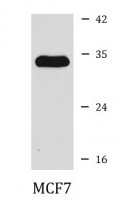ARG58094
anti-DHRS2 antibody
anti-DHRS2 antibody for ICC/IF,Western blot and Human,Mouse,Rat
Overview
| Product Description | Rabbit Polyclonal antibody recognizes DHRS2 |
|---|---|
| Tested Reactivity | Hu, Ms, Rat |
| Tested Application | ICC/IF, WB |
| Host | Rabbit |
| Clonality | Polyclonal |
| Isotype | IgG |
| Target Name | DHRS2 |
| Antigen Species | Human |
| Immunogen | Recombinant fusion protein corresponding to aa. 1-300 of Human DHRS2 (NP_878912.1). |
| Conjugation | Un-conjugated |
| Alternate Names | HEP27; Protein D; Dicarbonyl reductase HEP27; EC 1.1.1.-; Dehydrogenase/reductase SDR family member 2, mitochondrial; SDR25C1; Short chain dehydrogenase/reductase family 25C member 1 |
Application Instructions
| Application Suggestion |
|
||||||
|---|---|---|---|---|---|---|---|
| Application Note | * The dilutions indicate recommended starting dilutions and the optimal dilutions or concentrations should be determined by the scientist. | ||||||
| Positive Control | MCF7 | ||||||
| Observed Size | ~ 33 kDa |
Properties
| Form | Liquid |
|---|---|
| Purification | Affinity purified. |
| Buffer | PBS (pH 7.3), 0.02% Sodium azide and 50% Glycerol. |
| Preservative | 0.02% Sodium azide |
| Stabilizer | 50% Glycerol |
| Storage Instruction | For continuous use, store undiluted antibody at 2-8°C for up to a week. For long-term storage, aliquot and store at -20°C. Storage in frost free freezers is not recommended. Avoid repeated freeze/thaw cycles. Suggest spin the vial prior to opening. The antibody solution should be gently mixed before use. |
| Note | For laboratory research only, not for drug, diagnostic or other use. |
Bioinformation
| Database Links |
Swiss-port # Q13268 Human Dehydrogenase/reductase SDR family member 2, mitochondrial |
|---|---|
| Gene Symbol | DHRS2 |
| Gene Full Name | dehydrogenase/reductase (SDR family) member 2 |
| Function | Displays NADPH-dependent dicarbonyl reductase activity in vitro with 3,4-Hexanedione, 2,3-Heptanedione and 1-Phenyl-1,2-propanedione as substrates. No reductase activity is displayed in vitro with steroids, retinoids and sugars as substrates. Attenuates MDM2-mediated p53/TP53 degradation, leading to p53/TP53 stabilization and increased transcription activity, resulting in the accumulation of MDM2 and CDKN1A/p21. [UniProt] |
| Cellular Localization | Mitochondrion matrix, Nucleus. [UniProt] |
| Calculated MW | 30 kDa |
Images (2) Click the Picture to Zoom In







